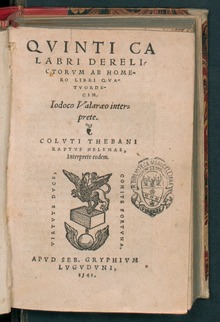Quintus Smyrnaeus
This article needs additional citations for verification. (May 2019) |
Quintus Smyrnaeus (also Quintus of Smyrna; Greek: Κόϊντος Σμυρναῖος, Kointos Smyrnaios) was a Greek epic poet whose Posthomerica, following "after Homer", continues the narration of the Trojan War. The dates of Quintus Smyrnaeus' life and poetry are disputed: by tradition, he is thought to have lived in the latter part of the 4th century AD, but early dates have also been proposed.[1]
His epic in fourteen books, known as the Posthomerica, covers the period between the end of Homer's Iliad and the end of the Trojan War. Its primary importance is as the earliest surviving work to cover this period, the archaic works in the Epic Cycle, which he knew and drew upon, having been lost. His materials are borrowed from the cyclic poems from which Virgil (with whose works he was probably acquainted) also drew, in particular the Aethiopis (Coming of Memnon) and the Iliupersis (Destruction of Troy) of Arctinus of Miletus, and the Ilias Mikra (Little Iliad) of Lesches.[2] His work is closely modeled on Homer.[3]
Life
The dates of Quintus's life are controversial,[4] but they are traditionally placed in the latter part of the 4th century AD. Way suggests that "His date is approximately settled by two passages in the poem, viz. vi. 531 sqq., in which occurs an illustration drawn from the man-and-beast fights of the amphitheatre, which were suppressed by Theodosius I. (379–395 AD); and xiii. 335 sqq., which contains a prophecy, the special particularity of which, it is maintained by Koechly, limits its applicability to the middle of the fourth century AD."[5]
Some scholars suggest an earlier date in the 3rd or even the 2nd century, arguing that his Posthomerica shows an influence from the "Second Sophistic", the school of Greek orators who flourished in the 1st and 2nd centuries.[6] According to his own account (xii. 310), he began composing poetry in his early youth while tending sheep near Smyrna (present-day İzmir).[citation needed]
A
The Posthomerica

The plot of Posthomerica begins where Homer's Iliad ends, immediately after
himself and the funeral games in his honour.Books five through twelve, covering the same ground as the
The remaining books, covering the same ground as
Editions
The
There has been a renewed interest in the poet and his poem in the twentieth century, with A. Way's translation (Loeb Classical Library vol. 19, 1913); a new edition of the text with partial commentary and French translation done by Francis Vian (3 vols. published by Budé, 1963, 1966, 1969); Frederick Combellack's English translation;[11] Alan James and Kevin Lee's detailed commentary on book 5;[12] and Alan James's English translation, with newly edited text and commentary.[13]
Citations
- ^ Baumbach & Bär (2007, pp. 2–8).
- ^ Maciver (2012, pp. 17–18).
- ^ Maciver (2012).
- ^ Baumbach & Bär (2007, pp. 2–8).
- ^ Way, A. S. (1913). Quintus Smyrnaeus: The Fall of Troy. Harvard University Press.
- ^ Baumbach & Bär (2007, pp. 2–8).
- ISBN 9780415141482.
- ^ Maciver (2012).
- ^ James & Lee (2000).
- ^ Cointi Smyrnaei, popularis Homeri, poëtae vetustissimi et suavissimi, Ilii excidii libri duo, Reditus Graecorum capta liber unus. Expositi olim in schola Ilfeldensi et editi nunc studio, industria et labore Laurentii Rhodomanni (Leipzig: Steinmann), 1577.
- ^ Combellack, Frederick (1968). The War at Troy: What Homer Didn't Tell, by Quintus of Smyrna. Oklahoma.
{{cite book}}: CS1 maint: location missing publisher (link). - ^ James & Lee (2000).
- ^ James (2004).
References
- Baumbach, M; Bär, S (2007). Quintus Smyrnaeus: Transforming Homer in Second Sophistic Epic. De Gruyter.
- James, Alan (2004). Quintus of Smyrna. The Trojan Epic. Posthomerica. Baltimore and London: Johns Hopkins University Press.
- James, Alan; Lee, Kevin (2000). A Commentary on Quintus of Smyrna, Posthomerica V. Brill.
- Maciver, Calum (2012). Quintus Smyrnaeus' Posthomerica: Engaging Homer in Late Antiquity. Brill.
Further reading
- Way, A. S., Quintus Smyrnaeus: The Fall of Troy, Translator: A.S. Way; Harvard University Press, Cambridge Massachusetts, 1913. Internet Archive
- Hermann Köchly (ed. major with elaborate prolegomena, 1850; ed. minor, 1853)
- Z. Zimmermann (author of other valuable articles on the poet), (1891)
- Franz Kehmptzow, De Quinti Smyrnaei fontibus ac mythopoeia (1889)
- C.-A. Sainte-Beuve, Etude sur . . . Quinte de Smyrne (1857)
- F.A. Paley, Quintus Smyrnaeus and the "Homer" of the tragic Poets (1879)
- G. W. Paschal, A Study of Quintus Smyrnaeus (Chicago, 1904).
- This article incorporates text from a publication now in the public domain: Chisholm, Hugh, ed. (1911). "Quintus Smyrnaeus". Encyclopædia Britannica. Vol. 22 (11th ed.). Cambridge University Press.
